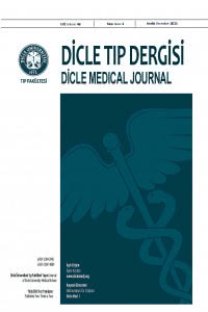Sıçanlarda intestinal derin iskemi-reperfüzyon modelinde ginkgo biloba ekstresinin (EGb761) profi laksi ve tedavide kullanımının mortalite üzerine etkisi
Prophylactic and therapeutic effect of ginko biloba extract (Egb761) on mortality of intestinal deep ischemia-reperfusion model in rats
___
- 1. Schoenberg MH, Beger HG. Reperfusion injuy after intestinal ischemia. Crit Care Med 1993;21:1376-86.
- 2. Kaleya RN, Sammartano RJ, Boley SJ. Aggressive approach to acute mesenteric ischemia. Surg Clin North Am 1992:72:157-82.
- 3. Megison SM, Horton JW, Chao H, Walker PB. Prolonged survival and decreased mucozal injury after low dose enteral allopurinol prophlaxis in mesenteric ischemia. J Pediatr Surg 1990;25:917-21.
- 4. Megison SM, Horton JW, Chao H, Walker PB. High dose versus low dose enteral allopurinol prophlaxis in mesenteric ischemia. Circulat Shock 1990;30:323-29.
- 5. Schneider TA, Longo WA, Ure T, Vernava AM. Mesenteric İschemia:Akut arterial sendreoms. Dis Colon Rectum 1994;37:1163-74.
- 6. Gerald BZ: Visceral occlusive disease. In Lazaar J Greenfi eld, Michael WM, Keith TO (eds): Surgery scientifi c principles and practice; Phlidelphia, Linncott Company,1993:1614-29.
- 7. Otamiri T, Tagesson C: Ginkgo biloba prevents mucosal damage associated with small intestinal ischemia. Scand J Gastroenterol 1989; 24: 666-70.
- 8. Parks DA, Granger DN: Contributions of ischemia and reperfusions to mucosal lesion formation. Am J Physiol 1986;250:749-60.
- 9. Zimmerman BJ, Granger DN. Reperfusion injury. Surg Clin North Am 1992;72: 65-83.
- 10. Krınsky NI: Membrane antioxidants. Ann NY Acad Sci 1988;551:17-32.
- 11. Reily PM, Schiller HJ, Bulkley GB. Pharmacologic approch to tissue injury mediated by free radicals and other reactive oxgen metabolites. Am J Surg 1991;161: 488-503.
- 12. Williams LF. Vascular insuffi ciency of the intestine. Gastroenterology 1971;61:757-77.
- 13. De Feudis, FV: Ginko Biloba Extract (EGb 761): Pharmacological activities and clinical applications. Elselvier, Paris,1991:1-26.
- 14. De Feudis FV: Ginko Biloba Extract (EGb 761 ) in perspective. Elsevier, Paris, 1999:10-48.
- 15. McKinsey JF, Gewertz BL. Acut mesenteric ischemia. Surg Clin North Am 1997; 77: 307-27.
- 16. Haimovici H: Muscular and metabolic complications of acut arterial occlusion: Myonefropatic metabolic syndrome. Surgery 1979;85:461-68.
- 17. Megison SM, Horton JW, Chao H, Walker PB: A new model for intestinal ischemia in the rat. J Surg Res 1990;49:168-73.
- 18. Adams JT: Abdominal wall, omentum, mesentery and retroperitonum. Scwartz SI, Shires G.T., Spencer FC, (ed): Principles of Surgery. Sixth edition, R.R. Donnelley and Sons Co, New York, 1994:1490-99.
- 19. Korthuis RJ, Smith JK,Carden DL. Hypoxic reperfusion attenuates postischemic microvascular injury. Am J Physiol 1989;256:315-22.
- 20. Mustafa NA, Yandı M, Turgutalp H, Ovalı E. Role of dilitiazem in ischemia-reperfusıon injury of the intestine. Eur Surg Res 1997;26:335-41.
- 21. Özden A, Kargıcı H, Bilgihan A, et al. Ratlarda intestinal iskemi ve reperfuzyon hasarında L-Carnitine’in etkisi. Cagdas Cerrahi Derg 1994;8:209-13.
- 22. Terzi C, Kuzu A, Tanık A, Kale T, Asalar K, Elhan A. The effects of short-and long-term prophylactic high-dose allopurinol treatment on mortality in a rat model of intestinal ischemia. Clin Exp Surg 2000;8:10-16.
- 23. Schoenberg MH, Muhl E, Sellin D, et al. Posthypotensive generation of superoxide radicals: Possible role in the pathogenesis of the intestinal mucosa damage. Acta Chir Scand 1984;150: 301-09.
- 24. Schoenberg, MH, Poch B, Younes M, et al. Involvement of neutrophils in postischemic damage to the small intestine. Gut 1991; 32: 905-12.
- 25. Horgan PG, Gorey TF. Operative assesment of intestinal viability. Intestinal ischemia. Surg Clin North Am 1992;72:143-55.
- 26. Schierwagen C, Bylund-Fellenius AC, Lundberg C. Improved metod for guantifi cation of tissue PMN accumulation measured by MPO activity. J Pharmacol Methods 1990;23:179-86.
- 27. Hernandez LA, Grisham MB, Twohig B, Arfors KE, Harlan JM, Granger DN. Role of neutrophils in ischemia reperfusion induced microvascular injury. Am J Physiol 1997;253:699-703.
- 28. Haznedaroglu SM, Pehlivan G, Terzioglu G, Erkek B, Demirer S, Ustbütün A, Canpolat O, Tüzüner A: Pentoksifi lin ve Ginko Biloba (EGb761)’in sıçanlarda alt extremite iskemi reperfüzyon hasarına etkisi. Ulusal Cerrahi Kon- gresi, 2000.
- 29. Pehlivan M, Dalbeler Y, Hazinedaroglu S, Arikan Y, Erkek AB, Günal O, Türkçapar N, Türkçapar AG. An assessment of the effect of Ginkgo Biloba EGb 761 on ischemia reperfusion injury of intestine. Hepatogastroenterol 2002;49:201-4.
- 30. Liu KX, He W, Rinne T, Liu Y, Zhao MQ, Wu WK. The effect of ginkgo biloba extract (EGb 761) pretreatment on intestinal epithelial apoptosis induced by intestinal ischemia/reperfusion in rats: role of ceramide. Am J Chin Med 2007;35:805-19.
- ISSN: 1300-2945
- Yayın Aralığı: 4
- Başlangıç: 1963
- Yayıncı: Cahfer GÜLOĞLU
Kabakulak virüsünün neden olduğu bir hepatit olgusu
Primer immün yetmezlikli çocuğa yaklaşım
Özlem Aktaş HANIMELİ, Özge YILMAZ, Hasan YÜKSEL
Muharrem KISKAÇ, Mehmet ZORLU, Mehmet VATANSEVER, Cüneyt ARDIÇ, Mustafa YENİGÜN, Ferhat YILMAZ
Aynı fabrikadan yemek alan iki inşaat firması işçilerinde meydana gelen toplu besin zehirlenmesi
Vedat DORMAN, Selda ASLAN, Ali CEYLAN, Seher Nacar KÜÇÜK, Ahmet GÜNEL, Hıdır SARI, Nedim YAŞLI, Demet YALIM
Zeki DOSTBİL, Çil HABİB, Ebru Özgür TEKBAŞ, Zuhal Arıtürk ATILGAN, Yahya İSLAMOĞLU, Bekir TAŞDEMİR, Yusuf DAĞ
Tissue necrosis following intramuscular diclofenac injection
Halit BAYKAN, Samet Vasfi KUVAT, Mehmet BOZKURT, Emin KAPI, Feyzi ÇELİK
Ünal ŞAHİN, Tayyar SELÇUK, Ercan DEMİRBAĞ, Birol CİVELEK, Selim ÇELEBİOĞLU
Üretrada nadir rastlanan bir yabancı cisim nedeni: Elektrik teli
Halit BAYKAN, Samet Vasfi KUVAT, Mehmet BOZKURT, Emin KAPI, Necmettin PENBEGÜL, Feyzi ÇELİK
Doksisiklin özofajiti: İki Olgu nedeniyle literatürün gözden geçirilmesi
Muhammed SAÇIKARA, Yaşar NAZLIGÜL, Güler KIZILCA, Oktay BULUR
Mehmet VATANSEVER, CÜNEYT ARDIÇ, Mehmet ZORLU, Muharrem KISKAÇ, Ferhat YILMAZ, Mustafa YENİGÜN
